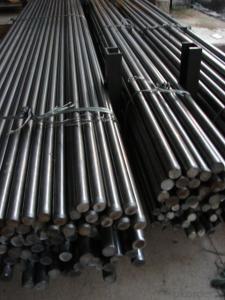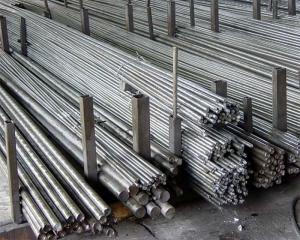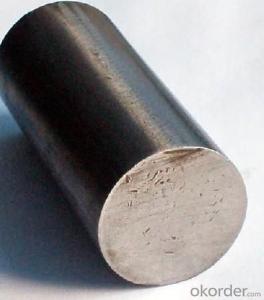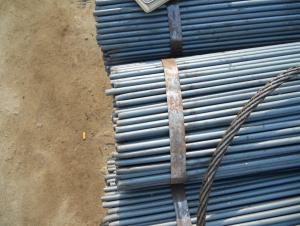GB 45#/SAE 1045 Steel Round Bar 32mm/35mm
- Loading Port:
- China main port
- Payment Terms:
- TT or LC
- Min Order Qty:
- 50 m.t
- Supply Capability:
- 10000 m.t/month
OKorder Service Pledge
OKorder Financial Service
You Might Also Like
GB 45#/SAE 1045 Steel Round Bar 32mm/35mm
Description:
-Specification: 32mm/35mm
-Length: 6m/12m
-Standard: GB/SAE/Japanese Standard
-Material: GB 45#/SAE1045/S45C
Chemical Composition of GB 45#/SAE 1045 Steel Round Bar 32mm/35mm:
| C | Si | Mn | P | S | Ni | Cr | Cu |
| 0.42-0.50 | 0.17-0.37 | 0.50-0.80 | ≤0.035 | ≤0.035 | ≤0.30 | ≤0.25 | ≤0.25 |
Packaging & Delivery of GB 45#/SAE 1045 Steel Round Bar 32mm/35mm:
Packaging Detail: All goods are packed in bundle with steel strips and shipped by break bulk vessel or container (depend on target market and different ports)
Delivery Detail: 45 days
MOQ: 50 tons per specification; we can negotiate the quantity if the specification is normal or we have stock of one specification.
Weight: The price invoicing on theoretical weight basis or actual weight basis depends on customer’s request.
Shipment: The shipment of bulk break or container is depends on customer’s request and the situation of the port of destination.
Documents given: Full set of original clean on board bill of lading; Original signed commercial invoice; Original packing list; Policy of insurance; Certificate of origin and what the target market needs.
Payment:
-Invoicing on theoretical weight or actual weight a s customer’s request.
-FOB, CFR or CIF.
-Regular terms of payment:
1, 30% payment in advance, the remaining balance (70% payment) against the copy of B/L.
2, 30% payment in advance, the remaining balance (70% L/C) against the copy of B/L.
3, Negotiable.
Images of GB 45#/SAE 1045 Steel Round Bar 32mm/35mm:


*If you would like to get our price, please inform us the size, standard/material and quantity. Thank you very much for your attention.
- Q:What are the different types of steel round bar alloys used in aerospace applications?
- In aerospace applications, there are various steel round bar alloys that are commonly utilized. These alloys are selected based on their specific properties and characteristics that render them appropriate for use in aircraft and spacecraft components. Some of the most frequently employed alloys include: 1. 4130: This is a low-alloy steel that contains chromium and molybdenum. Its exceptional strength and toughness make it ideal for applications such as landing gear components and structural tubing. 2. 4340: This nickel-chromium-molybdenum steel is renowned for its high strength and good ductility. It is commonly applied in gears, shafts, and structural components that necessitate high strength and toughness. 3. 17-4 PH: This alloy is a precipitation-hardening stainless steel that offers a combination of high strength, corrosion resistance, and good toughness. It is often utilized in aerospace applications where both strength and corrosion resistance are crucial, such as turbine blades and structural components. 4. 15-5 PH: Another precipitation-hardening stainless steel, this alloy provides high strength and good corrosion resistance. It is commonly found in aerospace applications like landing gear components and structural parts. 5. 9310: This low-alloy steel is recognized for its high hardenability and toughness. It is frequently employed in aerospace applications that require high strength and excellent impact resistance, such as gears and shafts. These examples highlight the diverse range of steel round bar alloys utilized in aerospace applications. Each alloy possesses specific properties and characteristics that make it suitable for fulfilling various component requirements in the aerospace industry.
- Q:Are steel round bars prone to deformation?
- Yes, steel round bars can be prone to deformation under certain conditions. Factors such as excessive heat, extreme pressure, or improper handling can cause steel round bars to bend, warp, or twist. However, when manufactured and used properly, steel round bars are highly durable and resistant to deformation.
- Q:What is the maximum titanium content allowed for steel round bars?
- The maximum titanium content allowed for steel round bars typically depends on the specific steel grade and composition. However, as a general guideline, the maximum titanium content in steel round bars is usually around 0.05-0.06%.
- Q:How do steel round bars compare to fiberglass round bars?
- Steel round bars and fiberglass round bars have different properties and characteristics, making them suitable for different applications. Steel round bars are known for their high strength and durability, making them ideal for heavy-duty applications such as construction, machinery, and automotive industries. They have a higher tensile strength and can withstand more stress and load compared to fiberglass round bars. On the other hand, fiberglass round bars are lighter in weight, have excellent corrosion resistance, and are non-conductive, making them suitable for applications that require electrical insulation or resistance to chemicals. Ultimately, the choice between steel and fiberglass round bars depends on the specific requirements of the project or application.
- Q:Special steel bar steel products used to do what
- But the red hardness difference of this kind of steel, that is, when the working temperature is greater than 250 degrees, the hardness and wear resistance of steel will decline rapidly, and lose their ability to work. In addition, carbon tool steels, such as those made of larger parts, are difficult to harden and easy to produce
- Q:What are the tolerances for steel round bars?
- The tolerances of steel round bars can differ based on the specific requirements of the application and manufacturing process. Generally, steel round bars have specified tolerances for diameter, straightness, and length. For diameter tolerance, it is usual to find tolerances ranging from +/- 0.001 inches to +/- 0.005 inches. This means that the actual diameter of the steel round bar can deviate within this range from the specified diameter. The size and grade of the bar determine the specific tolerance. Straightness tolerance refers to the permissible deviation in the straightness of the bar. Typically, it is specified as a maximum deviation per unit length, such as 0.125 inches per foot. This ensures that the bar remains straight and within acceptable limits when measured along its length. Length tolerance determines the allowable variation in the overall length of the round bar. It can range from +/- 0.125 inches to +/- 0.5 inches, depending on the size and grade of the bar. This ensures that the bar meets the required length specifications. It is important to note that these tolerances can vary based on industry standards, customer specifications, and the manufacturing method employed. Moreover, certain applications may have stricter tolerance requirements, particularly in industries like aerospace or automotive where precision is crucial. To summarize, the tolerances for steel round bars encompass diameter, straightness, and length. The specific tolerances depend on the size, grade, and application of the round bar, as well as any relevant industry standards or customer specifications.
- Q:Can steel round bars be used for making suspension components?
- Yes, steel round bars can be used for making suspension components. Steel is a common material used in the manufacturing of suspension components due to its high strength and durability. Steel round bars can be machined or forged into various shapes and sizes to meet the specific requirements of suspension components such as control arms, sway bars, and tie rods. The use of steel round bars ensures the suspension components can withstand the forces and stresses encountered during vehicle operation, providing stability, control, and safety.
- Q:How are steel round bars used in the automotive industry?
- Due to their strength, durability, and versatility, steel round bars are commonly employed in the automotive industry for a range of purposes. The production of crankshafts is one of the primary uses of steel round bars in this industry. Crankshafts are essential in converting the reciprocating motion of pistons into rotational motion, which powers the vehicle. Steel round bars are highly suitable for this function due to their high tensile strength, exceptional fatigue resistance, and ability to endure high torque loads. Steel round bars are also utilized in the manufacture of axles. Axles play a critical role in transferring power from the engine to the wheels while supporting the vehicle's weight and ensuring stability. Steel round bars provide the necessary strength and rigidity to handle the substantial loads and forces experienced by axles. Furthermore, steel round bars are employed in the production of suspension components like tie rods and sway bars. Tie rods are crucial for steering and maintaining proper alignment, while sway bars help control body roll and enhance handling. Steel round bars are preferred for these applications due to their exceptional torsional strength, enabling them to withstand the forces and stresses encountered during steering and suspension movements. Moreover, steel round bars are used in the creation of transmission shafts. Transmission shafts are responsible for transmitting power from the engine to the wheels through the gearbox. Steel round bars are well-suited for this task due to their high strength, resistance to bending, and ability to handle the rotational forces and torque generated by the engine. In conclusion, steel round bars are extensively employed in the automotive industry for various applications including crankshafts, axles, suspension components, and transmission shafts. Their superior strength, durability, and versatility make them an ideal choice for these critical components, ensuring the safety, performance, and reliability of vehicles.
- Q:Are steel round bars available in different shapes other than round?
- No, steel round bars are typically only available in round shapes. The term "round bar" refers specifically to a cylindrical shape with a circular cross section. However, there are other types of steel bars available in different shapes, such as square bars, flat bars, and hexagonal bars. These bars have specific applications and properties that make them suitable for different uses. So, while steel round bars are limited to round shapes, there are various other shapes of steel bars available in the market to cater to different requirements.
- Q:Can steel round bars be used for making musical instruments?
- Musical instruments can indeed be made using steel round bars. Steel is an incredibly versatile material, known for its outstanding strength and durability. This makes it highly suitable for a wide range of applications, including the creation of musical instruments. Steel round bars can be utilized in the fabrication of various musical instrument components, such as strings, rods, and even the principal body of certain instruments. The precise type and grade of steel utilized will ultimately depend on the specific instrument and the desired sound quality. For instance, steel bars are commonly employed in percussion instruments like xylophones or vibraphones, as they generate diverse pitches and tones. Furthermore, steel round bars can be employed in the production of components for wind instruments, including saxophones and trumpets. Nevertheless, it is important to note that selecting the appropriate material for musical instruments is often a complex process. Factors such as resonance, tonal quality, and playability must all be carefully considered. While steel round bars can be utilized, other materials like brass, wood, or even synthetic substances may be preferred for certain instruments in order to achieve the desired sound characteristics.
1. Manufacturer Overview |
|
|---|---|
| Location | |
| Year Established | |
| Annual Output Value | |
| Main Markets | |
| Company Certifications | |
2. Manufacturer Certificates |
|
|---|---|
| a) Certification Name | |
| Range | |
| Reference | |
| Validity Period | |
3. Manufacturer Capability |
|
|---|---|
| a)Trade Capacity | |
| Nearest Port | |
| Export Percentage | |
| No.of Employees in Trade Department | |
| Language Spoken: | |
| b)Factory Information | |
| Factory Size: | |
| No. of Production Lines | |
| Contract Manufacturing | |
| Product Price Range | |
Send your message to us
GB 45#/SAE 1045 Steel Round Bar 32mm/35mm
- Loading Port:
- China main port
- Payment Terms:
- TT or LC
- Min Order Qty:
- 50 m.t
- Supply Capability:
- 10000 m.t/month
OKorder Service Pledge
OKorder Financial Service
Similar products
New products
Hot products
Hot Searches
Related keywords































